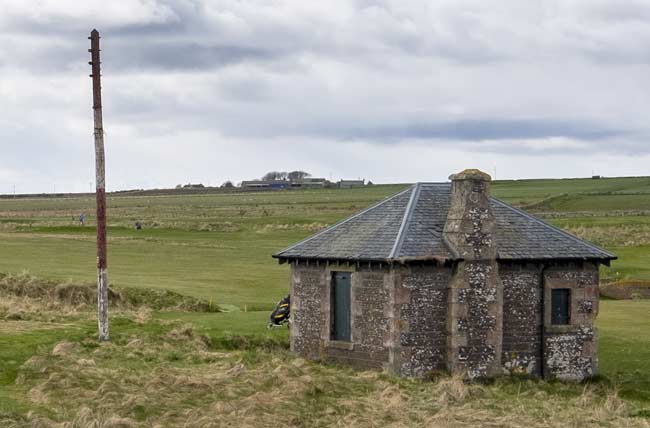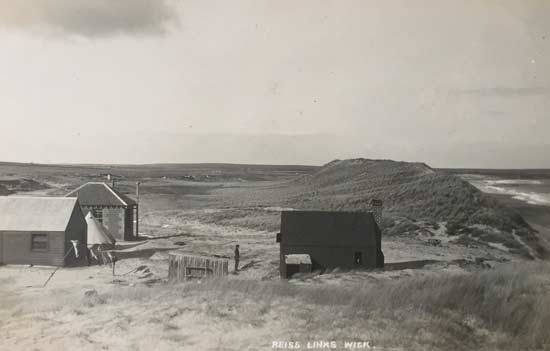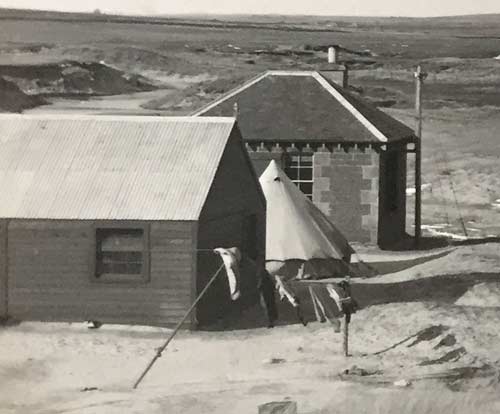In 1885 the GPO laid a direct cable from Sinclair Bay (near Wick on the east coast of the far north of Scotland) to Sandwick Bay, Lerwick, Shetland Islands, using its new cable ship Monarch (2). The single-conductor telegraph cable supplemented the indirect Shetland connection from the Scottish mainland via the 1876 Orkney cable and the 1881 Orkney-Shetland cable, and with a length of 122 nautical miles it was for many years the longest government cable in British waters.
In James R. Nicolson’s 1972 book on Shetland, the author gives this brief history of the cables to the Shetland Islands:
Between 1868 and 1870 the Orkney and Shetland Telegraph Company Ltd, floated with a capital of £20,000, laid a telegraph cable from Caithness to Boddam in Shetland; but it was subjected to strong tides and broke three times within the first year. In 1876, when it cost 13s 6d (67½p) to send a telegram of twenty words from Shetland compared with 1s (5p) from elsewhere in Britain, the struggling company was taken over by the General Post Office. In 1885 the latter laid a new cable between Sinclair Bay, Caithness, and Sandwick Bay in Shetland, and direct communications became possible between Lerwick and Aberdeen.
The John O’Groat Journal, in its issue of 22 July 1885, published this report on the laying of the cable:
The work of laying the cable between Aberdeen and Shetland has now been completed, and is in use. It will facilitate telegraphic communication between Shetland and the northern counties, and will be a great boon to those engaged in the herring trade. The new telegraph line is erected from Aberdeen to Burghead, then it passes as a cable through the Moray and Dornoch firths to Helmsdale, and from this it is a land wire till it reaches Wick. From Wick it is carried direct by cable to Lerwick. The parts of the line under water were laid by the cable ship Monarch, the work being carried out under the superintendence of Mr Lumsden, chief engineer. An experiment, very interesting in its way, was tried on Monday with the new wire, the officials in the Aberdeen office endeavouring to open up communication with the vessel while she was steaming ahead in the extreme north at the rate of 6½ knots an hour paying out the cable. The experiment proved remarkably successful, and when the connection was established the ship was sailing between the Fair Isle and Lerwick. Mr Taylor, acting superintendent, despatched a message to the chief engineer, Mr Lumsden, congratulating him on the success that had attended his labours, and hoping that they would be carried to a successful issue. To this, Mr Taylor got a reply immediately thanking the Aberdeen Office for their good wishes, and stating that by the following afternoon the connection with Lerwick would likely be completed. A message sent over the new line of wire was received on Tuesday, announcing the accomplishment of the work, on which all concerned are to be congratulated.
At Sinclair Bay the cable was terminated in a cable hut on the Reiss Links, a golf course running along the shore of the bay about three miles north of the town of Wick. The building was erected near the beach on what was then the sixth hole of the nine-hole course; this description is from a 21 February 1902 article in Golf Illustrated:
The sixth, called "The Cable Hole," is the most difficult of the course. There are sand bunkers of various sizes, a fence, a ditch, and on both sides long, thick bent, where a ball landed usually means loss. Strong players with a good drive, and a good second, surmount the difficulties, and may hole out in 4 with luck. The length is 332 yards; and Bogey, 6
In 1885, the year the cable was laid, the course was the home of the Wick Golf Club, which was established in 1870 and is the oldest golf club in the Highlands of Scotland. The club continues to occupy the course, which was enlarged to 18 holes in 1907, and the long-out-of-service cable hut, referred to locally as the “Cable House,” is now used for storage.
Although the hut remains in its original location, it is now near the green of the 16th hole.

Reiss Links Cable Hut photograph courtesy
of
and copyright © 2018 Robin Down
The view is of the north wall of the building
|
This is a description of the Cable House in July 2018:
The external size of the building is approx 18 ft by 15 ft.with walls approx 1 ft thick.As you go in the door you enter a flagstone floored lobby that is the full width of the hut.The lobby has an elevated access to a water tank and a loft access hatch. A doorway opens into the main area .This area has a blocked-up fireplace in the north wall and windows in the east and south walls. The walls are plastered and painted. The building appears to be wind and watertight.The floor in the main area is wooden planking local to the door.
Clearly this building is more than the typical cable hut, and because of the remote nature of the landing site it’s quite possible that the cable terminus was staffed.
This flyover video of the course shows the location of the cable hut beginning at about thirty seconds in, then continues by circling the building so it can be seen from all directions:
In 1892 telegraphic communication to Shetland was disrupted by faults on both the direct cable from Sinclair Bay and the connecting cable to Shetland from Orkney. This resulted in a question being asked in Parliament of the Postmaster General by the MP for Orkney and Shetland, as reported in
The Parliamentary Debates, 3 March 1892:
THE SHETLAND TELEGRAPH CABLES.
Mr. LYELL (Orkney and Shetland): I beg to ask the Postmaster General whether it is true, as reported, that both the telegraph cables to Shetland are broken; and, if so, when one or both of these cables will be repaired, so that telegraphic communication may be restored?
The POSTMASTER GENERAL (Sir J. Fergusson, Manchester, N.E.): When the hon. Member gave notice of this question, both cables to Shetland were broken; but the direct cable from Sinclair Bay in Caithnessshire was repaired yesterday, and the cable ship of the Department will now proceed to repair the local cable from the Orkneys.
In 1908 both the Sinclair Bay cable to Shetland and the 1876 cable to Orkney from Dunnet Bay, about 17 miles north-west of Reiss, suffered coincidental failures. This description of the twin failures in The Electrical Engineer issue of January 3, 1908, includes useful details of the route of the telegraph connection from Aberdeen to Sinclair Bay:
Orkney.—Through some unexplained cause a complete breakdown of the telegraphic system between Orkney, on one hand, and Shetland, on the other, with the mainland has taken place, and telegrams are being sent on by steamer. It is impossible to say what has occasioned the breakdown, which is remarkable in respect that the two groups of islands are supplied independently and that the cables lying in the Pentland Firth are 20 miles apart.
The system to the northern islands is on land from Aberdeen to Burghead, where the Moray Firth is crossed by cable to Helmsdale. There is then a land line to Sinclair Bay for the Shetland Islands, the cable lying 20 miles to the east of the Orkney cable, which leaves the mainland at Dunnet Bay. The weather in the Pentland Firth has been very stormy, but the breakdown of the cables is not thereby explained.
During the First World War the cable landing point at Reiss Links was defended by soldiers, as was the case with other cable installations which might become military targets, and Reiss Links has two photographs from WWI in its archives.
The first photo shows soldiers in front of a tent adjacent to the Cable House, and has the date September 1914 scribbled on the back. WWI started in late August 1914 and it looks like the Cable House protection was a top security priority, with soldiers bivouacing locally soon after the declaration of war. The other photo also shows the tent, as well as ancillary buildings in the locality of the Cable House. Both photos were taken by Mr JG Humphrey, a local professional photographer.
Photographs by JG Humphrey courtesy of Reiss Links, April 2021

“Unofficial Group” at Reiss, September 1914
|

The Cable House (second from left) and ancillary buildings |

Detail of the Cable House, September 1914
The view shows the south wall of the building
Compare with the April 2021 view below |

Photograph by Roy Mackenzie |
The cable appears to have still been in service in 1945, as in the April 1945 issue of the Post Office Electrical Engineers’ Journal is this report of tests made at the site:
FICTITIOUS TESTS WITH TESTER No. 36.
During corrosion investigations on the land cables leading to the submarine cable hut at Sinclair Bay, Wick, sheath current was found flowing towards the cable hut and out to sea on the armouring of the submarine cables. The neighbourhood is entirely of rock with a shallow covering of sand, and the submarine cable armouring is used as the cable hut earth, bonded to the land cables.
Testing with a No. 36 tester, a sheath current of several hundred milliamperes on the land cables was found to have increased to 4-5 amperes on the armouring of the submarine cables.
Investigations indicated that there was no possibility of additional pick-up of current in the vicinity of the hut, and it appeared therefore that the results obtained with tester No. 36 were fictitious. It seemed probable that at the contact between the copper test wire and the iron armouring of the cable, the presence of a film of sea water would lead to the generation of a small voltage. to cancel which would require a heavy current from the battery of the tester. Careful drying of the armouring, and care in making the connections resulted in steady sheath currents approximating to these measured on the land cable sheaths and confirmed this view.
The mention of “submarine cables” (plural) suggests that there may have been a second cable at the landing point, but there is no record at all of any cable at Sinclair Bay other than the one laid in 1885. A survey of cables around the Shetlands recorded in the Marine License Application for the new Havfrue Cable System (laid in 2019) reports only this one out of service cable running to Sinclair Bay: “OOS Telegraph, Sandwick Bay-Sinclair Bay.”
The Shetlands were poorly served by improvements in telecommunications during the 20th century, eventually relying on expensive and unreliable microwave links to the mainland. In 2006 the Faroese installed SHEFA2, a fibre optic link which crossed the Shetland Islands on its way to its terminus in Aberdeenshire, and in December 2009 Shetland Islands Council undertook a project to connect Shetland to the Faroese cable itself. According to Shetland Telecom, “This network ensures that Shetland has, for the first time, reliable, high capacity, affordable high speed internet access between the islands and the rest of the UK.”

Reiss Links Cable Hut photographs courtesy
of
and copyright © 2018 Robin Down |
 |
|

